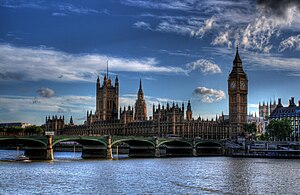Difference between revisions of "Ossulstone"
m |
|||
| Line 1: | Line 1: | ||
[[File:Hdr parliament.jpg|right|thumb|300px|Westminster, Middlesex]] | [[File:Hdr parliament.jpg|right|thumb|300px|Westminster, Middlesex]] | ||
[[File:Ossulstone Hundred in Middlesex.svg|right|thumb|200px|The Hundred of Ossulton in Middlesex]] | [[File:Ossulstone Hundred in Middlesex.svg|right|thumb|200px|The Hundred of Ossulton in Middlesex]] | ||
| − | '''Ossulstone''' is a Hundred in the | + | '''Ossulstone''' is a Hundred in the south-east of the county of [[Middlesex]].<ref name=map>British History Online - [http://www.british-history.ac.uk/image.aspx?compid=22200&filename=fig06.gif&pubid=84 Hundreds of Middlesex]</ref> Its area has been entirely absorbed by the growth of London; and now corresponds to the part of ''Inner London'' that is north of the [[River Thames]] and, from ''Outer London'', parts of the London boroughs of Barnet, Brent, Ealing, Haringey and Hounslow. |
| − | This is the largest and most urban of the county's six hundreds, bordering four others: [[Edmonton Hundred|Edmmonton]] and [[Gore Hundred|Gore]] to the north | + | This is the largest and most urban of the county's six hundreds, bordering four others: [[Edmonton Hundred|Edmmonton]] and [[Gore Hundred|Gore]] to the north; [[Elthorne Hundred|Elthorne]] in the west; and [[Isleworth Hundred|Isleworth]] to the south-west. The Hundred of Ossultone extends to the borders of four counties: [[Essex]] across the [[River Lea]] in the east, [[Surrey]] and [[Kent]] across the [[River Thames]] to the south and [[Hertfordshire]] in the north. |
==History and Geography== | ==History and Geography== | ||
Revision as of 13:20, 25 June 2018
Ossulstone is a Hundred in the south-east of the county of Middlesex.[1] Its area has been entirely absorbed by the growth of London; and now corresponds to the part of Inner London that is north of the River Thames and, from Outer London, parts of the London boroughs of Barnet, Brent, Ealing, Haringey and Hounslow.
This is the largest and most urban of the county's six hundreds, bordering four others: Edmmonton and Gore to the north; Elthorne in the west; and Isleworth to the south-west. The Hundred of Ossultone extends to the borders of four counties: Essex across the River Lea in the east, Surrey and Kent across the River Thames to the south and Hertfordshire in the north.
History and Geography
The hundred is named after "Oswald's Stone" or "Oswulf's Stone", an unmarked monolith, possibly pre-Roman, which was situated at Tyburn (the modern-day junction of the Edgware Road with Bayswater Road). It is possible that this stone might have been named after a Middle Saxon king and it is likely that early assemblies or "moots" of the Middle Saxon people were organised here. Oswald's Stone was earthed over in 1819, but dug up again three years later because of its presumed historical significance. Later in the 19th century it was to be found leaning against Marble Arch following its move. In 1869, shortly after an archaeological journal published an article about it, the stone disappeared and it has not been identified since.[2]
The Ossulstone Hundred is bounded on all sides by rivers. To the south its border is the River Thames, to the east it borders the River Lea and to the north and west it is bordered by the River Brent. The authorities of the Hundred never had authority in the City of London, which it surrounded to the west, north and east.[3] Historically it contained numerous "liberties" wherein the usual authorities were excluded to some extent or entirely, which included the City and Liberty of Westminster, the Savoy Liberty (belonging to the Duchy of Lancaster), the Tower Liberty, the Rolls Liberty and the Saffron Hill Liberty (at Ely Place, belonging to the Bishop of Ely).
References
- ↑ British History Online - Hundreds of Middlesex
- ↑ Ossulstone Hundred -VCH A History of the County of Middlesex: Volume 6: Friern Barnet, Finchley, Hornsey with Highgate (1980), pp. 1-5
- ↑ British History Online - Divisions of Ossulstone hundred

